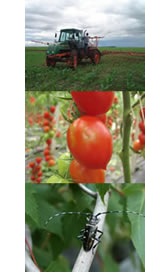
EPPO Council Colloquium
Plant Health and Plant Protection: links, interactions and future challenges
Bonn (DE) 2011-09-22
After the administrative session of the EPPO Council, a Colloquium was organized to discuss the following theme: Plant Health and Plant Protect ion: links, interactions and future challenges. At the kind invitation of the Federal Ministry of Food, Agriculture and Consumer Protection, the Colloquium took place in Bonn, Germany. More than 60 participants from 31 EPPO member countries, as well as from EFSA, the EU Commission and the IPPC Secretariat, attended. Ms Schorn (Head of the NPPO, DE) was glad to welcome the Colloquium on the occasion of EPPO's 60th Anniversary and wished the participants successful discussions on this topical theme. Warm thanks are due to Ms Schorn, Ms Neikes and their colleagues for the excellent organization of the Council session and Colloquium.
ion: links, interactions and future challenges. At the kind invitation of the Federal Ministry of Food, Agriculture and Consumer Protection, the Colloquium took place in Bonn, Germany. More than 60 participants from 31 EPPO member countries, as well as from EFSA, the EU Commission and the IPPC Secretariat, attended. Ms Schorn (Head of the NPPO, DE) was glad to welcome the Colloquium on the occasion of EPPO's 60th Anniversary and wished the participants successful discussions on this topical theme. Warm thanks are due to Ms Schorn, Ms Neikes and their colleagues for the excellent organization of the Council session and Colloquium.
The possible links between the plant health and plant protection sectors were introduced by several speakers and then discussed by the Colloquium. Although there was some confusion in the terminology used: ‘plant health’, ‘plant quarantine’, and ‘plant protection’, it was generally accepted that ‘plant health’ and ‘plant protection’ were broadly covering the ‘plant quarantine’ and ‘plant protection products’ sectors, respectively. Several speakers illustrated with examples how ‘plant health’ and ‘plant protection’ were two major sectors for NPPOs, and thus for EPPO. The interdependency between ‘plant health’ and ‘plant protection’ could even be reflected in the administrative structures of the NPPOs, but in any case good communication between the units in charge was considered essential. For NPPOs (as well as for the EU), one of the main objectives is to control plant pests efficiently while ensuring the safety of humans, animals and the environment.
In this context, NPPOs are currently faced with several challenges: how to control an increasing number of new pests; how to ensure safe trade at global level and how to better protect human health and the environment from risks associated with the use of plant protection products. The necessity for better protection of human health and the environment has led to the withdrawal of a large number of plant protection products in many EPPO countries, sometimes leaving NPPOs and growers with very limited options for chemical control. Another important point presented was how the legislation (in particular the EU legislation) was currently being elaborated to respond to these challenges (e.g. new plant health regime, sustainable use of pesticides). Concerning the links between ‘plant protection’ and ‘plant health’, it was noted that the sustainable use of plant protection products implied that control strategies should better take into account the use of plant quarantine, healthy planting material, and other options included in IPM (Integrated Pest Management); while at the same time, plant quarantine should rely on the availability of effective control strategies when eradicating or containing outbreaks.
The Colloquium also noted that the assessment of risks related the emergence of new pests, as well as on the impact of plant protection products were key issues when establishing control strategies against plant pests at national and international level. The use of cost-benefit analysis was also found to be necessary when defining control strategies. It was recognized that although ‘plant protection’ and ‘plant health’ required different tools, management options and decision-making schemes, more synergies should be found at national and international level.
Finally, the following points were highlighted by the Colloquium as being important when protecting plants from damage by pests (including diseases):
- Prevent and be prepared
- use of healthy planting material
- Integrated Pest Management
- strengthening of import measures
- generic contingency planning
- establishment of incentive and risk sharing mechanisms for growers
- surveillance
- identification
- early warning (Alert systems)
- report as soon as possible
- Evaluate risk and identify measures
- prediction models
- cost-benefit analysis (when appropriate, evaluation of different scenarios)
- eradication/contingency plans
- phytosanitary treatments
- Improve communication on pest risks between national structures in charge of both sectors (plant quarantine and plant protection), stakeholders, and the general public
Presentations
Evolution of International Framework for Plant Health
Y. Yokoi (Secretary of the IPPC, FAO)
Integrated approach for plant protection and plant health
M. E. Poudelet (Director for Safety of the Food Chain, DG SANCO – European Commission)
Plant health issues from the perspective of EFSA’s involvement in the area of plant protection product
H. Fontier (Head of the Pesticides Unit, EFSA)
Framework on plant health and plant protection products in Norway
H. Paulsen (Senior Adviser for the Norwegian NPPO, NO)
The new plant health strategy in Ukraine
L. Pilipenko (Institute of Plant Protection UA)
Plant health and plant protection: the French experience
E. Soubeyran (Head of the NPPO, FR)
Plant protection and plant health - links, interactions and future challenges: case study for Turkey
N. Birisik (Head of Plant Health and Quarantine, TR)
Plant protection and plant health: the German experience
K. Schorn (Head of the NPPO, DE)
